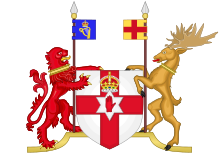This article needs additional citations for verification. (August 2020) |
Parliament of Northern Ireland | |
|---|---|
| Devolved Parliament | |
 Arms of Northern Ireland, 1924–1972 | |
| Type | |
| Type | |
| Houses | |
| History | |
| Established | 7 June 1921 |
| Disbanded | 30 March 1972 |
| Preceded by | UK Parliament (1801–1921) |
| Succeeded by | Northern Ireland Assembly (1973) |
| Leadership | |
Lord Glentoran (last) | |
Ivan Neill (last) | |
| Elections | |
| Elected by the Commons via STV | |
| |
| Meeting place | |
 | |
| Parliament Buildings, Stormont, Belfast | |
| (1921–72) |
 |
|---|
The Parliament of Northern Ireland was the home rule legislature of Northern Ireland, created under the Government of Ireland Act 1920, which sat from 7 June 1921[1] to 30 March 1972, when it was suspended because of its inability to restore order during the Troubles, resulting in the introduction of direct rule. It was abolished under the Northern Ireland Constitution Act 1973.
The Parliament of Northern Ireland was bicameral, consisting of a House of Commons with 52 seats, and an indirectly elected Senate with 26 seats. The Sovereign was represented by the Governor (initially by the Lord Lieutenant), who granted royal assent to Acts of Parliament in Northern Ireland, but executive power rested with the Prime Minister, the leader of the largest party in the House of Commons.
- ^ Parliamentary Debates of Northern Ireland (accessed 7 August 2012), Volume 1 (1921) / Page 1, 7 June 1921.